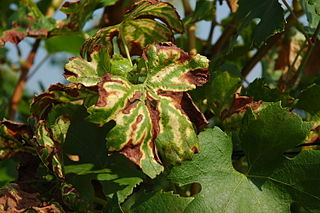![Eumycetoma chronic granulomatous[1] fungal disease[2] of humans, affecting mainly the limbs, and sometimes the abdominal and chest walls or the head](https://upload.wikimedia.org/wikipedia/commons/thumb/5/59/Madura_foot..JPG/320px-Madura_foot..JPG)
Eumycetoma is a chronic granulomatous fungal disease of humans, affecting mainly the limbs, and sometimes the abdominal and chest walls or the head. Mycetoma pedis, the most common form of mycetoma, is known widely as the Madura foot. The infection is endemic in Africa, India and Central and South America.

Dead arm, sometimes grape canker, is a disease of grapes caused by a deep-seated wood rot of the arms or trunk of the grapevine. As the disease progresses over several years, one or more arms may die, hence the name "dead arm". Eventually the whole vine will die. In the 1970s, dead-arm was identified as really being two diseases, caused by two different fungi, Eutypa lata and Phomopsis viticola.

Acremonium is a genus of fungi in the family Hypocreaceae. It used to be known as Cephalosporium.
Acremonium strictum is an environmentally widespread saprotroph species found in soil, plant debris, and rotting mushrooms. Isolates have been collected in North and Central America, Asia, Europe and Egypt. A. strictum is an agent of hyalohyphomycosis and has been identified as an increasingly frequent human pathogen in immunosuppressed individuals, causing localized, disseminated and invasive infections. Although extremely rare, A. strictum can infect immunocompetent individuals, as well as neonates. Due to the growing number of infections caused by A. strictum in the past few years, the need for new medical techniques in the identification of the fungus as well as for the treatment of human infections has risen considerably.

Aquilaria crassna is a species of plant in the Thymelaeaceae family. It is found in throughout Southeast Asia and in New Guinea.

Aquilaria malaccensis is a species of plant in the Thymelaeaceae family. It is found in Bangladesh, Bhutan, India, Indonesia, Laos, Malaysia, Myanmar, the Philippines, Singapore, and Thailand. It is threatened by habitat loss.

The Pleosporales is the largest order in the fungal class Dothideomycetes. By a 2008 estimate it contains 23 families, 332 genera and more than 4700 species. The majority of species are saprobes on decaying plant material in fresh water, marine, or terrestrial environments, but several species are also associated with living plants as parasites, epiphytes or endophytes. The best studied species cause plant diseases on important agricultural crops e.g. Cochliobolus heterostrophus, causing southern corn leaf blight on maize, Phaeosphaeria nodorum causing glume blotch on wheat and Leptosphaeria maculans causing a stem canker on cabbage crops (Brassica). Some species of Pleosporales occur on animal dung and a small number occur as lichens and rock-inhabiting fungi.

Dothideomycetidae is a subclass of Dothideomycetes consisting of three orders: Dothideales, Myriangiales and Capnodiales. The cavities of the sexual structures do not have vertical cells growing between the sac-like cells bearing the sexual spores (asci).

Capnodiales is a diverse order of Dothideomycetes, initially based on the family Capnodiaceae, also known as sooty mold fungi. Sooty molds grow as epiphytes, forming masses of black cells on plant leaves and are often associated with the honeydew secreted by insects feeding on plant sap. This diverse order has been expanded by the addition of several families formerly thought unrelated and now also includes saprobes, endophytes, plant pathogens, lichens and rock-inhabiting fungi. The new additions include the genus Mycosphaerella containing the causal agents of several economically important crop and tree diseases. A small number of these fungi are also able to parasitise humans and animals, including species able to colonise human hair shafts.

Pseudallescheria boydii is a species of fungus classified in the Ascomycota. It is associated with some forms of eumycetoma, maduromycosis and pseudallescheriasis. Typically found in stagnant and polluted water, it has been implicated in the infection of immunocompromised and near-drowned pneumonia patients. Its asexual (anamorphic) form is Scedosporium apiospermum. Treatment of infections with P. boydii is complicated by its resistance to many of the standard antifungal agents normally used to treat infections by filamentous fungi.

Richard C. Summerbell is a Canadian mycologist, author and award-winning songwriter. He was editor in chief of an international scientific journal in mycology from 2000 to 2004. In the 1970s and 80s, he was a gay activist and an early commentator on (then) controversial topics such as AIDS and promiscuity and attitudes to homosexuality in organized religion.

Esca is a grape disease of mature grapevines. It is a type of grapevine trunk disease.
Phialemonium curvatum is a pathogenic fungus in the phylum Ascomycota. The genus was created to accommodate taxa intermediate to Acremonium and Phialophora. This genus is characterized by its abundance of adelophialides and few discrete phialides with no signs of collarettes. Specifically, P. curvatum is characterized by its grayish white colonies and its allantoid conidia. Phialemonium curvatum is typically found in a variety of environments including air, soil, industrial water and sewage. Furthermore, P. curvatum affects mainly immunocompromised and is rarely seen in immunocompetent people. The species has been known to cause peritonitis, endocarditis, endovascular infections, osteomyelitis as well as cutaneous infections of wounds and burns.
Phaeomoniella chlamydospora is a fungus species of mitosporic ascomycota in the genus Phaeomoniella.
Togninia is a fungus genus and the type genus in the family Togniniaceae. It is the teleomorph of Phaeoacremonium.
Phaeoacremonium aleophilum is a fungus species in the genus Phaeoacremonium. It is associated with Phaeomoniella chlamydospora in esca in mature grapevines and decline in young vines, two types of grapevine trunk disease.

Neoscytalidium dimidiatum was first described in 1933 as Hendersonula toruloidea from diseased orchard trees in Egypt. Decades later, it was determined to be a causative agent of human dermatomycosis-like infections and foot infections predominantly in the tropical areas; however the fungus is considered to be widespread. A newer name, Scytalidium dimidiatum, was applied to synanamorph of Nattrassia mangiferae, otherwise known as Neofusicoccum mangiferae. Substantial confusion has arisen in the literature on this fungus resulting from the use of multiple different names including: Torula dimidiata, Scytalidium dimidiatum, Fusicoccum dimidiatum, and Hendersonula toruloidea.

Phialemonium obovatum is a saprotrophic filamentous fungus able to cause opportunistic infections in humans with weakened immune systems. P. obovatum is widespread throughout the environment, occurring commonly in sewage, soil, air and water. Walter Gams and Michael McGinnis described the genus Phialemonium to accommodate species intermediate between the genera Acremonium and Phialophora. Currently, three species of Phialemonium are recognized of which P. obovatum is the only one to produce greenish colonies and obovate conidia. It has been investigated as one of several microfungi with potential use in the accelerated aging of wine.

Cladosporium sphaerospermum is a fungus belonging to the genus Cladosporium and was described in 1886 by Albert Julius Otto Penzig from the decaying leaves and branches of Citrus. It is a dematiaceous (darkly-pigmented) fungus characterized by slow growth and largely asexual reproduction. Cladosporium sphaerospermum consists of a complex of poorly morphologically differentiated, "cryptic" species that share many physiological and ecological attributes. In older literature, all of these sibling species were classified as C. sphaerospermum despite their unique nature. Accordingly, there is confusion in older literature reports on the physiological and habitat regularities of C. sphaerospermum in the strict sense. This fungus is most phylogenetically similar to C. fusiforme. According to modern phylogenetic analyses, the previously synonymized species, Cladosporium langeroni, is a distinct species.
Exophiala pisciphila is a mesophilic black yeast and member of the dark septate endophytes. This saprotrophic fungus is found commonly in marine and soil environments. It is abundant in harsh environments like soil contaminated with heavy metals. E. pisciphila forms symbiotic relationships with various plants by colonizing on roots, conferring resistance to drought and heavy metal stress. It is an opportunistic pathogen that commonly causes infections in captive fish and amphibians, while rarely causing disease in humans. Secondary metabolites produced by this species have potential clinical antibiotic and antiretroviral applications.

![Eumycetoma chronic granulomatous[1] fungal disease[2] of humans, affecting mainly the limbs, and sometimes the abdominal and chest walls or the head](https://upload.wikimedia.org/wikipedia/commons/thumb/5/59/Madura_foot..JPG/320px-Madura_foot..JPG)












